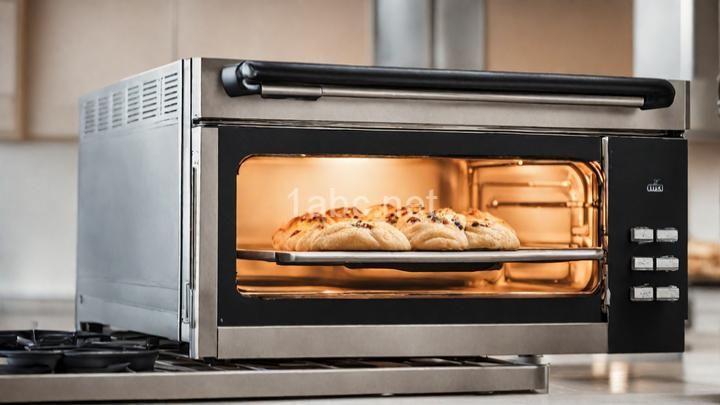Unleashing the Power of Convection: Baking Tips for Convection Ovens

Introduction:
Welcome, dear readers, and thank you for choosing to join us on this baking journey infused with the power of convection ovens. Here at dorenelashay9177, we strive to provide you with friendly and informative discussions that will bring your baking skills to new heights. In this blog post, we will unravel the mysteries of convection ovens and equip you with the knowledge and techniques to become a convection baking maestro. So, buckle up and get ready to unleash the power of convection!
I. Understanding Convection Ovens
Before we dive into the world of convection baking, let's take a moment to understand what convection ovens are and how they differ from conventional ovens. A convection oven is a type of oven that utilizes a fan and an exhaust system to circulate hot air evenly throughout the cooking chamber. This circulation of hot air allows for faster and more even cooking, resulting in perfectly baked goodies.
The science behind convection cooking is quite fascinating. As the fan in the oven circulates the hot air, it creates a convection current that envelops the food being cooked. This constant flow of hot air ensures that the heat reaches all sides of the food simultaneously, leading to quicker and more uniform cooking. The benefits of using a convection oven for baking are numerous. It helps in achieving crispy crusts, even browning, and shorter cooking times, all while preserving the moisture and tenderness of your baked goods.
II. Preparing Your Convection Oven
Now that we have a grasp of the magic behind convection cooking, let's move on to preparing your convection oven for the baking extravaganza. The first step is to preheat your oven to the desired temperature. To do this, simply set the oven to the required temperature and allow it to heat up. The beauty of convection ovens is that they often have a preheating feature that speeds up the process, so you can jump right into baking.
It's important to note that cooking time and temperature may need to be adjusted when using a convection oven. The powerful air circulation in convection ovens can cause food to cook faster than in a conventional oven. As a general rule of thumb, reduce the cooking temperature by about 25 degrees Fahrenheit and decrease the cooking time by about 25%. However, it's always best to consult the recipe or perform a few test runs to determine the exact adjustments needed for your specific oven.
Properly positioning the racks in your convection oven is crucial for achieving even heat distribution. For the best results, it's recommended to place your baking pans on the middle rack. This ensures that the hot air circulates evenly around the food, resulting in uniformly baked goodies. If you're baking multiple pans at once, make sure to leave enough space between them to allow for proper air circulation.
III. Mastering Baking Techniques with Convection Ovens
A. Baking Basics:
Before we delve into the art of achieving perfectly golden brown crusts and ensuring even baking, let's cover some baking basics that work exceptionally well with convection ovens. First and foremost, let's talk about essential baking tools. When it comes to convection baking, using light-colored and shiny pans is highly recommended. These types of pans help reflect the heat more efficiently, resulting in better browning and even cooking.
Accurate measurement of ingredients is paramount in baking, and this holds true for convection baking as well. Ensure that you measure your ingredients accurately using measuring cups and spoons. A slight variation in measurements can have a significant impact on the final outcome of your baked goods.
B. Achieving Perfectly Golden Brown Crusts:
Now, let's move on to the art of achieving those coveted golden brown crusts. Whether you're baking bread, pies, or pastries, there are a few techniques that can elevate your crust game. One way to achieve a crispy crust is by using the steam or water bath method. This involves placing a pan of hot water on the bottom rack of your oven while baking. The steam generated helps create a moist environment, allowing for a beautifully browned and crispy crust.
C. Ensuring Even Baking:
To ensure even baking in your convection oven, it's important to be mindful of a few strategies. Uneven browning or undercooking can occur if the hot air is not reaching all sides of the food equally. One way to combat this is by rotating your pans halfway through the baking process. This simple step ensures that each side of your baked goods is exposed to the hot air and receives the same amount of heat.
D. Dealing with Delicate Desserts:
When it comes to delicate desserts like soufflés or meringues, baking in a convection oven requires an extra level of vigilance. These delicate treats can be prone to overcooking or collapsing if not carefully monitored. Keep a close eye on the baking process and be ready to adjust the cooking time accordingly. It's also a good idea to lower the oven temperature slightly to prevent rapid browning and to maintain the delicate texture of these desserts.
IV. Troubleshooting Common Challenges in Convection Baking
Even the most seasoned bakers encounter challenges in the world of convection baking. Overbrowning or uneven rising are common issues that can arise when using a convection oven. Fear not, for we have some practical solutions and troubleshooting techniques for you. If you find that your baked goods are browning too quickly, simply cover them with foil halfway through the cooking process to prevent further browning. On the other hand, if your baked goods are not rising evenly, it may be due to the intense air circulation in the convection oven. To remedy this, try reducing the oven temperature slightly or placing a baking stone on the bottom rack to absorb excess heat.
V. Cleaning and Maintenance Tips
Now that you've become a convection baking pro, it's important to know how to properly clean and maintain your convection oven. Regular cleaning helps to maintain the efficiency and longevity of your oven. Start by removing any food debris or spills from the oven's interior using a damp cloth or sponge. For stubborn stains, a mixture of baking soda and water can work wonders. Avoid using harsh chemicals or abrasive cleaners, as they can damage the oven's interior. Finally, don't forget to clean the oven's exterior and accessories, such as racks and trays, to keep everything looking and functioning at its best.
Conclusion
Congratulations, dear readers, on unlocking the secrets of convection baking! We hope this journey has been as delightful for you as it has been for us. Remember, the key to becoming a convection baking maestro lies in practice and experimentation. Don't be afraid to try new recipes and techniques, and always trust your instincts. We thank you for joining us today and encourage you to explore other helpful content on our blog. Until next time, happy convection baking!
FREQUENTLY ASKED QUESTIONS
How does a convection oven differ from a regular oven?
A convection oven differs from a regular oven in how it circulates heat. While a regular oven uses radiant heat to cook food, a convection oven utilizes a fan and exhaust system to distribute hot air evenly throughout the oven cavity. This circulating air helps to cook food more quickly and evenly, resulting in faster cooking times and more consistent results.In a regular oven, the heat source is typically located at the bottom or top of the oven, causing uneven heat distribution. This can result in hot spots and cold spots within the oven, leading to uneven cooking. On the other hand, a convection oven's fan helps to distribute the hot air, ensuring that the heat reaches all areas of the oven cavity evenly. This helps to eliminate hot spots and promotes consistent cooking.
The circulating hot air in a convection oven also has another benefit: it helps to brown and crisp the exterior of food more effectively. This is particularly useful when baking or roasting dishes such as pastries, meats, and vegetables. The consistent heat and airflow in a convection oven can result in a beautifully golden and crispy exterior, while still maintaining moisture on the inside.
It's worth noting that some convection ovens offer the option to switch between convection and regular baking modes. This flexibility allows you to choose the cooking method that best suits your needs for each recipe.
In summary, a convection oven differs from a regular oven by utilizing a fan and exhaust system to circulate hot air, resulting in faster and more even cooking. This feature is especially beneficial when it comes to browning and crisping food.
Can I use my regular baking recipes in a convection oven?
Yes, you can definitely use your regular baking recipes in a convection oven! However, there are a few things to keep in mind when making the switch. Convection ovens work by using a fan to circulate hot air, resulting in faster and more even baking. Here are a few tips to help you adapt your recipes for a convection oven:
-
Temperature adjustment: Convection ovens tend to bake food faster than conventional ovens, so you may need to reduce the temperature by about 25 degrees Fahrenheit (or 15 degrees Celsius) compared to what your recipe suggests. This will help prevent your baked goods from browning too quickly on the outside while remaining undercooked inside.
-
Baking time: Due to the efficient heat distribution in convection ovens, your baking time may be shorter. It's always a good idea to start checking for doneness a few minutes earlier than the recipe specifies. Keep an eye on your baked goods to ensure they don't overcook.
-
Multiple trays: If you're baking multiple trays of cookies or other treats, remember to rotate them halfway through the baking process. This will ensure even browning and prevent any one tray from getting too much direct heat.
-
Use shallow pans: For best results, opt for shallow baking pans or sheets. This allows the hot air to circulate more effectively around your food, resulting in a more consistent bake.
Remember, these adjustments may vary depending on your specific convection oven model, so it's always a good idea to consult your oven's manual for any additional recommendations or guidelines.
Happy baking in your convection oven! Enjoy the benefits of faster and more evenly baked treats.
What are the benefits of baking with a convection oven?
Baking with a convection oven comes with several benefits. First and foremost, convection ovens use a fan to circulate hot air throughout the oven cavity, resulting in even and consistent heat distribution. This means that your baked goods will be cooked more evenly, with a golden and crispy exterior and a moist and tender interior.Additionally, convection ovens can help you save time in the kitchen. The circulating hot air reduces cooking time by up to 25%, allowing you to bake your favorite treats faster. This is especially useful when you have multiple batches to prepare or when you're pressed for time.
Another advantage of baking with a convection oven is its ability to handle multiple racks at once. The even heat distribution ensures that all the racks receive the same amount of heat, eliminating the need for rotating the trays during baking. You can bake cookies, cakes, and other goodies on different racks simultaneously, maximizing your oven's capacity.
Furthermore, convection ovens are great for achieving a nice crust on your baked goods. The circulating hot air helps to remove moisture from the surface, resulting in a crispy and golden crust. Whether you're baking bread, pastries, or pizzas, a convection oven can take your creations to the next level.
Lastly, convection ovens are versatile. They not only excel at baking but also offer additional cooking functions such as roasting and broiling. You can roast a chicken to perfection or broil your favorite vegetables with ease. With a convection oven, you have a versatile tool that can handle a variety of cooking tasks.
In summary, the benefits of baking with a convection oven include even heat distribution, reduced cooking time, the ability to handle multiple racks, achieving a crispy crust, and versatility in cooking. So why not give it a try and elevate your baking game with a convection oven?
Do I need to preheat a convection oven?
Yes, it is recommended to preheat a convection oven before using it. Preheating allows the oven to reach the desired temperature and ensures that your food will cook evenly and thoroughly. By preheating, you are giving the oven time to distribute heat evenly throughout the cooking chamber, which leads to better cooking results. So, before you start cooking, it's a good idea to preheat your convection oven to the recommended temperature specified in your recipe or the appliance's manual.


